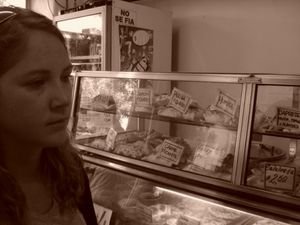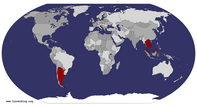Advertisement
Published: October 22nd 2007

 Hot Pocket Shop
Hot Pocket Shop
Suz examines the selection at a little old lady's empañada store.Where to begin on conveying how we have fallen in love with this city? Spending a year in the extremely different cultures of Southeast Asia may have had a hand in it, but arriving in the distinctly European - and therefore western - capitol of Argentina has felt like coming home. A certain intertwining between things comforting, and the not-too-exotic-but-still-enticing customs exists here that has us secretly fantasizing about ways to remain forever. But what to write about? How can I express why we enjoy the city of the porteños so much?
I could write about the old colonial architecture, with it´s massive stone statues that still try to keep watch over a population that has long since forgotten who they are.
Or I could write about the passionate tango dancers, who draw crowds along the streets of the brightly painted buildings in the famously rowdy La Boca district. (Forgot to bring my camera that day)
I could tell you how Argentina is full of night-owls. Eating lunch at 1:30 in the afternoon, and not finishing their dinner until well after midnight.
I could write about the hundreds of speed-bumps on every street that keep the insane

 Huge Colonial Building
Huge Colonial Building
I think this is a school.taxi-drivers in check.
Or how at least one-third of the population wears Converse sneakers.
Or that a 23-cent subway ticket can take you ANYWHERE (even if you change lines) in the city.
I could tell you about the wonderful cooking class we took in a suburban home, and how making Empanadas in Teresita's rustic kitchen completely redefined my outlook on food preparation.
Or I could describe our immense feeling of relief and gratitude to a cabbie who rescued us from walking through Buenos Aires' worst neighborhood.
I could eleborate on how millions of Germans, Italians, and Jewish people all immigrated here to live amongst the Argentinos, almost as if WWII had never happened.
And I could elaborate more to tell you how the Italians prevailed in making pizza a necessity on every menu in the city.
I could describe the impressive (and creepy) Recoleta cemetary: a city of the dead contained in 4-story high walls where elaborate tombs and crypts hold the remains of Buenos Aires' most politicly, militarily, and socially affluent people over the last 300 years.
Or I could tell the story of how Suz and I walked into a

 El Subte
El Subte
Best Way to Get Around BAhuge communist rally in the Plaza de Mayo of downtown Buenos Aires, drawn to the hypnotic drum music and bright red banners that commemorated the 40th year since Che Guevara's assasination in Bolivia (once again, I left the camera at home).
I could describe the 40-foot high ceiling of the room at our guesthouse, or the scent of the savory cazuela-style casseroles, or attempt to relive the hustle and bustle of a saturday night in any one of the busy plazas surround by bars and nightclubs, but there is one particular experience that we had that I think best sums up why we love Buenos Aires.
It was the steak dinner.
Suz and I had been eating at various
parillas during our week long stay in BA, but on our last night we really wanted to go out with a bang. After asking the guesthouse, and putting in the standard hours of internet research, we had finally settled on El Cabrera: a place so well known for it´s enormous cuts of beef that they opened a second restaurant just half a block away from the original. We had purposely starved ourselves that day in order to make

 Empañada 101
Empañada 101
Teresita shows the proper way to crimp the edges.room for our selected feast, but waited too long to arrive at the front door without a reservation. The place was packed. Even on a Tuesday night it was difficult to get a seat at 9:00, and we were informed that the wait would be at least 30 minutes.
Luckily El Cabrera knows how to keep it´s potential clients from walking away in search of quicker eats. As 20 or so of us stood on the street corner in the light rain and chilly night air, we were treated like wedding guests during a cocktail hour. Boards of cubed provalone and slices of cured sausage were passed around, replaced as quickly as they could be eaten by the apparently starving crowd. Glasses of champagne and cups of red and white wine were handed out as soon a group added it´s name to the list. Time passed by quickly, and before we knew it we were seated at a large round table in the corner of the main dining room, franticly eyeing what other diners had on their plates.
We ordered two bottles of water and a bottle of Malbec to ensure we could wash the meal down (Malbec

 City in a City
City in a City
One of the many "streets" in the city of the dead.is the tannin-laden varietal that Argentina is known for, and it´s no coincidence that it pairs up perfectly with the country´s best-known livestock). Once we had drink in hand, we were presented with the ubiquitous cornicopia of bread that comes out before every meal in this country. Breadsticks, herb-brushed croustades, baguette, slices of two different types of homeade loaves, and a whipped cheese and cream spread whose flavor changes with the whim of each restaurant´s chef. Even though we knew we shouldn´t waste the room - every square inch would be needed - our stomachs just refused to stop their incessant whining, and we unconciously found our mouths full of the tasty spoiler.
Even worse, when our eyes hit the appetizer page all sense of logic and reason disappeared in a barely noticable puff of smoke. Most appetizers in Argentina cost almost as much as the entrees - and with good reason. They are just as large and equally as filling. A plate of
fiambres (cured meats and cold cuts) and
quesos can easily satisfy a table of four at the start of a meal, and an order of 5 or 6 empañadas - that oh-so-filling inspiration for the

 The Beginning of the End
The Beginning of the End
Our first round of appetizer: the tasty jamon crudoHot Pocket - is just an exercise in gluttony. In the week that Suz and I spent in Buenos Aires, we found that you can´t even order a sandwich without having to look for random people on the street to come in and help you finish it. But then again, when that same sandwich only costs you $4, what does it matter if you throw in the towel only half-way through? We promptly ordered a plate of thinly sliced cured ham with all the fixins, and what ended up being an entire small wheel of grilled goat´s milk provalone with a pile of marinated tomatoes on top.
The proscuitto-like ham was the salty-savory deliciousness that we always look for as a starter. In a last attempt at sanity, we only picked at the olives, fresh mozzarella, oven-dried tomatoes, and salad that it came with. We knew our fate was sealed from the first bite of the grilled provalone. The inside was warm and gooey like baked brie, and the slightly tangy flavor from the goat´s milk had us elbowing each other out of the way for the next bite. We used even more of the bread to wipe up

 Second Course
Second Course
Pile of grilled cheese anyone?the rendered fat that had mixed with the oil from the marinated tomatoes. Sitting back to unbuckle our belts, Suz and I looked at each other and realized that we had been in fantasy land for the last 20 minutes, and certainly hadn´t considered the implications of what was coming next.
A word about beef in Argentina: it is the best in the world. None of the cheating methods are used here; no growth hormones, no antibiotics, no corn mixed with the ruminants of other animals. Cows wander the endless expanse of Patagonian fields eating the nutrient-rich grass that they were always meant to, herded by the idyllic
Gauchos on horseback behind them. If you think the "modern improvements" made to American beef are just as good as the old-fashioned way - think again. Our cost-effective way of raising cattle has removed a natural richness and flavor that has left it utterly bland. I had no idea how good beef could be until I tried it in Argentina. Sure, the Japanese make some fine steak with their massaged kobe cows drinking sake out of golden troughts, but at $100 a pound they can keep it. I´ll pick a huge

 The Main Event
The Main Event
This cost $13.slab of good old cow-in-a-pasture stuff over that anyday.
The main even arrived on a huge wooden board with grooved channels cut into it to collect the juices that slowly oozed from the surface of the meat. We had selected the
bife de chorizo, the Argentinos most popular cut which is prized for the flavorful lines of fat that run through it. It´s a large cut, usually described as "rump steak", and I guessed ours to weigh about 20 oz. We found renewed strength at the sight of our wood-grilled hunk of flesh, but were dismayed to discover that it came with 12 side dishes. We quickly pushed them off to the sides and dismissed them as distractions from the real reason we had come here.
The first bites, unbelievably tender and a perfect mid-rare, exceeded all expectations. I wasnt´s so much chewing as I was sucking on the meat. Suzanne felt a tingle run through her body that made her visibly shiver. We worked slow and deliberately, making sure no smidgen of meat was left on the discarded pieces of gristle (that I ended up eating anyway when there was nothing left). Each bite was dragged back
through the rivers of salty juice that had accumulated on the board, a natural sauce that would have been offensive with the addition of any other ingredient. The side dishes looked sad from being ignored (with the exception of the ramiken of roasted garlic), but their various combinations of mayonaise and starch couldn´t compete. It was heaven, and without a doubt the best steak we have ever had in our lives.
We were overstuffed but giggling with happines for the rest of our meal. We simply could not believe how the steak that changed our lives had only cost us $13. Dessert was out of the question, but coffee was ordered in our attempt to get the stomach to start working harder at the daunting task that lay before it. While waddling back home we couldn´t stop talking about how good it was, and that night I feel asleep with the fantasy of myself as a
Gaucho, riding my horse into a wood-fired sunset with hundreds of pounds of
bife de chorizo as far as the eye could see.
For those of you that don´t know, we ended our trip in Southest Asia and returned to Columbus for 
 The Aftermath
The Aftermath
Oh, the sweet, sweet agonyRyan and Tracy´s wedding weekend. The day after, we took off for Buenos Aires. Having travelled 3 continents in 3 weeks, we will write the blogs that we are experiencing now, and will hopefully return to the lost months in Indonesia at a later time.
Advertisement
Tot: 0.133s; Tpl: 0.013s; cc: 13; qc: 49; dbt: 0.039s; 1; m:domysql w:travelblog (10.17.0.13); sld: 1;
; mem: 1.2mb



















jen
non-member comment
I dont know what to say...
you guys are eating your way around the world...and doing a mighty fine job at it....keep up the good work...you are an inspiration...